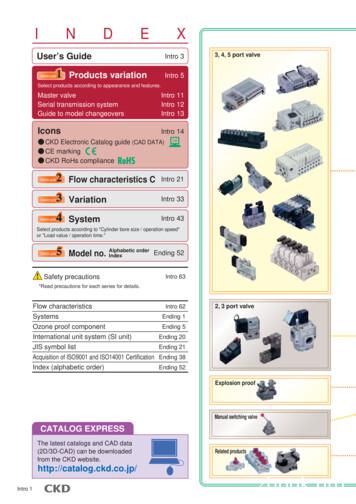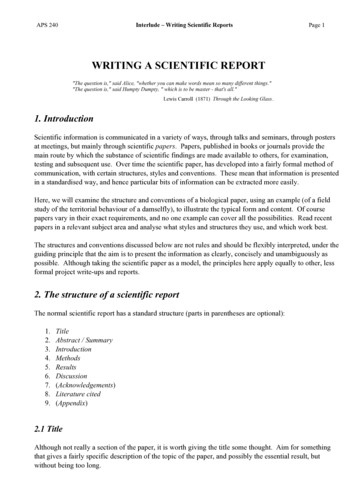MIXING VALVE TECHNOLOGIES
MIXING VALVE TECHNOLOGIESAn Overview Brought To You By:ESP AgencySpeaker: Buddy Francioni & Doug Ruckman1“Mixing Valves 101”What is a Mixing Valve?A device specifically designed to transport supply hot and cold water intoa mixing chamber, blend and then deliver tempered, stable water at thedesired outlet temperatures to downstream fixtures and fittings.Where is it Used?Typical applications include temperature control of domestic hot waterdistribution loops, sinks, line/lavatory control, tubs, and/or showers, andemergency drench equipment.21
“Mixing Valves 101”1976, American Legion Conference in Philadelphia – over4,000 attendees and over 40% became ill with flu-likesymptoms. Unfortunately, 34 people died, including 2 of themen in this picture.It CDCwasn’tuntil January1977, thatthe tLegionnaire'sbacteriasuggestedthatthe bacteriaspreadDiseaseandeachyear, withdeathresulting wasin 5-30%of fromthem.themist from a rooftop cooling tower.3“Mixing Valves 101”Why is a Mixing Valve Needed? Hot Water is typically stored at 140 F in order to kill Legionella bacteria. This is too hot to be delivered to the end user, and therefore, it must be mixedwith cold water to deliver safe, tempered water to the domestic hot watersystem (typically 120 F). Ensuring constant, safe outlet temperatures can also aid in the prevention ofscalding. Using a mixing valve can also extend the storage capacity & size of the hotwater source.42
ASPE Research Foundation & ASHRAErecommend 140 F as the temperatureto combat Legionellae bacteria5“Mixing Valves 101”Scalding Risks- For most people, the risk of scalding is negligible below 120 F, butincreases in severity as temperatures increase:Temperature120 F130 F140 FTime for 2nd deg burn8 min17 sec3 secTime for 3rd deg burn10 min30 sec5 sec63
7www.asse-plumbing.org84
5 ASSE Standards that Applyto Mixing Valves: ASSE 1016ASSE 1017ASSE 1069ASSE 1070ASSE 1071 (and ANSI Z 358.1-2009)www.asse-plumbing.org9“Mixing Valves 101”Types of Mixing ValvesThermostaticThermostatic mixing valves react very well to changes intemperature, but they can also handle pressure variations (around10%). They will maintain stable outlet temperatures given largeinlet temperature variations. Typically, Thermostatic Valves willonly change 1 degree outlet temperature for every 8 degree inlettemperature change .8 Rule.Technologies There are 3 types of thermostats and each hastheir benefits and downfalls:1) Bi-metal2) Wax (aka Paraffin)3) Bellows105
“Mixing Valves 101”Types of Mixing ValvesPressure-Balanced These devices can protect against injuries resulting from thermalshock (excessive hot or cold). The danger of thermal shock is that theindividual’s sudden movement away from the water coming from theshower could cause a fall and serious injury. This concern is evengreater with the elderly. The US Consumer Products Safety Committee says that there areabout 3,800 injuries and 34 deaths per year that are the direct result ofexcessive hot water; with elderly and people with mental and physicaldisabilities being the most susceptible.11“Mixing Valves 101”Types of Mixing ValvesDigital/ Electronic Mixing Valves Electronic Controls Faster reactions, instant feedback eliminates control failures Electronic Motor Stronger than all thermostatic motors! Communication with the Building Management System Allows Monitoring for Legionella Self Balancing No more Balancing Issues at start up and down the line. More Accurate Control ,- 2 Degrees Temperature Tolerance, per ASSE 1017 testing guidelines Accountability Data logging126
IPC/UPC & Mixing ValvesChapter 4 Fixtures, Faucets and Fixture FittingsSection 416.5 Tempered water for public hand-washing facilities“Tempered water shall be delivered from lavatories and group wash fixtureslocated in public toilet facilities provided for customers, patrons and visitors.Tempered water shall be delivered through an approved water-temperaturelimiting device that conforms to ASSE 1070 or CSA B125.3.” (Similarlanguage in UPC Section 421.2)13IPC/UPC & Mixing ValvesChapter 4 Fixtures, Faucets and Fixture FittingsSection 424.3 Individual shower valves“Individual shower and tub-shower combination valves shall be balancedpressure, thermostatic or combination balanced-pressure/thermostatic valves thatconform to the requirements of ASSE 1016 or ASME A112.18.1/CSAB125.1and shall be installed at the point of use. Shower and tub-shower combinationvalves required in this section shall be equipped with a means to limit themaximum setting of the valve to 120 F (49 C), which shall be field adjusted inaccordance with the manufacturer’s instructions. In-line thermostatic valvesshall not be utilized for compliance with this section.” (Similar language inUPC Section 408.3)147
IPC/UPC & Mixing ValvesChapter 4 Fixtures, Faucets and Fixture FittingsSection 424.4 Multiple (gang) showers“Multiple (gang) showers supplied with a single-tempered water supply pipeshall have the water supply for such showers controlled by an approvedautomatic temperature control mixing valve that conforms to ASSE 1069 or CSAB125.3, or each shower head to be individually controlled by a balancedpressure, thermostatic or combination balanced-pressure/thermostatic valves thatconform to the requirements of ASSE 1016 or CSA B125.1 and is installed at thepoint of use. Such valves required in this section shall be equipped with a meansto limit the maximum setting of the valve to 120 F (49 C), which shall be fieldadjusted in accordance with the manufacturer’s instructions.” (Similarlanguage in UPC Section 408.3)15IPC/UPC & Mixing ValvesChapter 4 Fixtures, Faucets and Fixture FittingsSection 424.5 Bathtub and whirlpool bathtub valves“The hot water supplied to bathtubs and whirlpool bathtubs shall be limited to amaximum temperature of 120 F (49 C) by a water-temperature limiting devicethat conforms to ASSE 1070 or CSA B125.3, except where such protection isotherwise provided by a combination tub/shower valve in accordance withSection 424.3.” (Similar language in UPC Section 409.4)168
IPC/UPC & Mixing ValvesChapter 6 Water Supply and DistributionSection 607.1.1 Temperature limiting means“A thermostat control for a water heater shall not serve as the temperaturelimiting means for the purposes of complying with the requirements of this codefor maximum allowable hot or tempered water delivery temperature at fixtures.”17IPC/UPC & Mixing ValvesChapter 6 Water Supply and DistributionSection 613.1 Temperature-actuated mixing valve“Temperature-actuated mixing valves, which are installed to reduce watertemperature to defined limits, shall comply with ASSE 1017.” (There is nolanguage in UPC about 1017)189
Thermostatic ElementsThermostatic mixing valves use a sensing element (Bi-metalcoil, liquid filled bellows, wax filled bellows, etc.) to senseincoming hot and cold supply water and blend it to thedesired outlet temperature.19Thermostatic ElementsLeonard Thermostatic Design:DURA-trol bi-metal thermostat2010
Thermostatic ElementsFeatures of the DURA-trol bi-metal thermostat: Most durable element available Fastest reaction time due to bi-metal’s direct contact with the water stream No supply temperature limitations (up to live steam) No outlet temperature range limits Simple design - only 1 moving part (bi-metal directly linked to valve porting) Easily cleaned, spares not required at time of purchase21Thermostatic ElementsWax FilledLiquid-filled BellowsThese other thermostats employ temperature-sensing elements that contain either awax or an incompressible liquid. As the temperature increases, the cup (or housing)heats and then transmits the heat to the thermostatic element, therefore causing itsvolume to expand. This displacement is transmitted hydraulically through a piston orpush rod . Note that both elements require a spring to return the thermostat to itsorigin.2211
Proportionalincrease tocold inletRestrictionof hot inletWhen there is an inlet temperature or pressure fluctuation that causes arise in outlet temperature, the highly responsive paraffin elements expandand move a piston. This allows for a restriction in the hot supply and aproportional increase in cold supply, thus maintaining the desired outputtemperature.23Valve operation for the various types ofthermostatic elementsNext Generation Bi-Metal High/Low ValveXL Single Valve High/Low ValveNucleus Digital Mixing Valve2412
Installation“FOLLOW MANUFACTURER’SSUGGESTED PIPING DIAGRAMS”Method # 2Circulated flow isless than 8 GPMMethod # 4Circulated flow isgreater than 8 GPMMethod “W”Wax Models only25Large Valve High FlowSmall Valve Low FlowD-6AMETHOD #2DUAL VALVE HIGH/LOW SYSTEMBALANCING VALVE ANDCHECK ON EACH RETURN LINEDOMESTIC WATERSUPPLYTEST OUTLETBY OTHERSTHERMOMETERNotes:CFHIGH TEMPERATUREWATER1.) Do not combine thetempered water returnand high temperaturewater return into asingle common returnline cirulator.RLEONARDT HERMOST AT I Cts 2 .97 0 ,7 0 & 3 ,0 61 ,19 5 3 .15 2, 67 0R.INARDOLEALVECO.HOTWATERSOURCE.U .S.A.T YPE T MASSE1170VNNSTOATEMPEREDCIRCULATORCBy-Pass Piping No Flow2.) Swing check valvesmounted in horizontalpositions are preferable.ASSE0 1173/4" BY-PASSLINE WITH CHECK3.) Check valves mountedin the vertical positionshould be spring loaded.HEATTRAP4.) Ball valves should befull port line size.BLADDER TYPETHERMALEXPANSIONTANKDOMESTIC WATERRETURNBALANCINGVALVECOLDSUPPLYHIGH TEMPERATURE RETURNCNOTE: ELIMINATE IF NO HIGHTEMPERATURE WATER RETURN2613
Piping Method # 2Two Valve High Low SystemCirculated Flow is Eight (8) GPM or LessMarch 6, 2019Presented by: Coleman-Russell &Associates Inc272727Wax Valves – Piping MethodMethod “W”Wax Models only2814
Troubleshooting How to identify and correct problems:“Is the mixing valve the issue or not?” Step 1 – What Is the Complaint/Issue?– Get as much information from the user as possible Listen to the symptoms Step 2 – Questions to ask? Is this a new installation? What type of mixing valve is installed? Is this a renovation? Was a mixing valve installed before, and did it work? Has the valve ever work correctly? At what times does the problem occur? At what times is the watertemperature ok? Has other work been done to any part of the hot water system recently?29TroubleshootingFocus in on Where to Start:At times of demand Focus on the mixing valves,supply piping, heat source, fixturesAt times of no demand Focus on return piping,balancing valves, circulatorsCommon Problems:* Return line plumbed to cold water supply and not tothe bottom port of mixing valve* No hot water to mixing valve* Demand is lower than minimum flow of mixing valve* Valve is too small* Check valves in wrong direction3015
3116
MIXING VALVE TECHNOLOGIES An Overview Brought To You By: ESP Agency Speaker: Buddy Francioni & Doug Ruckman What is a Mixing Valve? A device specifically designed to transport supply hot and cold water into a mixing chamber, blend and then deliver tempered, stable water at the desired outlet temperatures to downstream fixtures and fittings.
mechanical mixing (rotating, vibrating) hydraulic mixing pneumatic mixing pipeline mixing (turbulent flow, static mixer) Method of mixing fluids A –mechanical mixing using turbines B –mechanical mixing using blade impellers C –hydraulic mixing D –pneumatic mixing with stationary inputs
the flow rate and pressure. To select the correct valve to fulfill these functions properly, an outline of the different types of valves and their features is given below. Butterfly valve Butterfly valve and globe valve Butterfly valve and ball valve Butterfly valve and gate valve Check valve Gate valve Globe valve Ball valve Valve shaped like a
G- Autoflow Valve 2.0 GPM H- Autoflow Valve 2.5 GPM I- Autoflow Valve 2.8 GPM J- Autoflow Valve 3.0 GPM K- Autoflow Valve 3.3 GPM L- Autoflow Valve 3.5 GPM M- Autoflow Valve 4.0 GPM N- Autoflow Valve 4.5 GPM O- Autoflow Valve 5.0 GPM P- Autoflow Valve 5.5 GPM Q- Autoflow Valve 6.0 GPM R- Autoflow Valve
l The interchangeable mixing valve mechanism EUROTHERMalso contributes to savings, while making it possible to renovate a mixing valve at a limited cost. l It is commonly accepted that a thermostatic mixing valve provides energy savings of 30% compared to a simple mixing valve.
4 I MIRKA ESSENTIALS PAINT MIXING mirka.com PAINT MIXING SOLUTIONS The Mirka Paint Mixing product range includes mixing cups, lids & systems, mixing sticks, paint strainers, practical dispensers and cloths. Caters for automative refinishing professional paint mixing needs. Size Mirka Code Pcs/pack 180ml 9190170180 50 400ml 9190170400 50
4, 5 port pilot operated valve 4TB 5 port pilot operated valve (pneumatic valve) 4L2-4/LMFO 3, 4, 5 port pilot operated valve (pneumatic valve) 4KA/4KB 5 port pilot operated valve (pneumatic valve) 4F 5 port pilot operated valve (ISO conformed valve) PV5G/PV5/CMF 3 port direct acting valve (small pneumatic valve) 3MA0/3MB0
two position control valve temperature / pressure relief valve angle valve safety relief valve 3-way mixing valve 3-way diverting valve safety valve with drip pan elbow automatic air vent and shutoff valve manual air vent chain operated valve s m vb m-001 hvac legends & notes gwin engineering consultants, llc 1306 commerce drive, norman, ok 73071
APS 240 Interlude Ð Writing Scientific Reports Page 5 subspecies of an organism (e.g. Calopteryx splendens xanthostoma ) then the sub-species name (xanthostoma ) is formatted the same way as the species name. In the passage above you will notice that the name of the damselfly is followed by a name: ÔLinnaeusÕ. This is the authority, the name of the taxonomist responsible for naming the .























